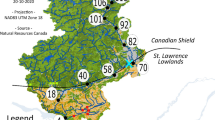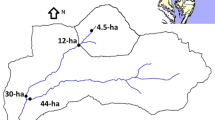Abstract
Seasonal influences and the role of floodplain forest as source or sink of organic matter is relatively unknown for 3arge, temperate rivers. Discharge and fine-particulate (FPOC), dissolved (DOC), and total organic carbon concentrations (TOC) were measured during five sampling periods from November, 1984, to August, 1985, above and below the floodplain-forested area (1054 ha) of Burlington Island in navigation Pool 19, upper Mississippi River. Sampling coincided with autumnal leaf fall of the floodplain forest, peak flood and falling spring flood, and low-flow conditions prior to and during phytoplankton bloom. Greatest TOC transport occurred during peak flood (8.84 × 106 Kg/day) and leaf fall (7.79 × 106 Kg/day). Peak flood transport was dominated by FPOC associated with flushing of material from upland areas. Transport during autumnal leaf fall was predominantly DOC attributed to litter leaching. Seasonal DOC loads generally increased downstream except during the phytoplankton bloom when a decrease was associated with increased microbial metabolic activity. Downstream decline in FPOC and increasing DOC loads during peak flood characterized the mechanism of deposition and processing of FPOC on the floodplain. FPOC concentration was significantly correlated to discharge and DOC concentrations were higher than FPOC except for peak flood. Significant downstream changes in TOC load suggests the importance of riparian vegetation as an influence on organic matter transport in large rivers.
Similar content being viewed by others
References
Anderson, R. V. & D. M. Day, 1986. Predictive quality of macroinvertebrate — habitat associations in lower navigation pools of the Mississippi River. Hydrobiologia 136: 101–112.
Brinson, M. M., 1977. Organic matter losses from four watersheds in the humid tropics. Limnol. and Oceanogr. 21: 572–582.
Brinson, M. M., H. D. Bradshaw, & R. N. Holmes, 1983. Significance of floodplain sediments in nutrient exchange between a stream and its floodplain. In T. D. Fontaine III & S. M. Bartell (eds), Dynamics of lotic ecosystems. Ann Arbor Science, Ann Arbor, Mich.: 199–222.
Carlander, K. D., C. A. Carlson, V. Gooch & T. L. Wenke, 1967. Populations ofHexagenia mayfly naiads in Pool 19, Mississippi River, 1959–1963. Ecology 48: 873–878.
Cummins, K. W., J. R. Sedell, F. J. Swanson, G. W. Minshall, S. G. Fisher, C. E. Cushing, R. C. Petersen & R. L. Vannote, 1983. Organic matter budgets for stream ecosystems: Problems in their evaluation. In J. R. Barnes & G. W. Minshall (eds). Stream ecology: Application and testing of general ecological theory. Plenum Press, NY: 299–353.
Fremling, C. R., 1960. Biology of a large mayfly,Hexagenia bilineata (Say), of the upper Mississippi River. Res. Bull. Iowa St. U. Agric. Home Econ. exp. Sta. 482: 842–852.
Gale, W. F., 1975. Bottom fauna of a segment of Pool 19, Mississippi River, near Fort Madison, Iowa, 1967–1968. Iowa St. J. Res. 49: 353–372.
Guy, H. P. & V. W. Norman, 1976. Field methods for measurement of fluvial sediment. Chapter 2, Book 3, Techniques of water-resources investigations of the United States Geological Survey. US Govt. Printing Off., Washington, D. C., 59 pp
Hedges, J. I., W. A. Clark, P. D. Quay, J. E. Richey, A.H. Devol & U. de M. Santos, 1986. Compositions and fluxes of particulate organic material in the Amazon River. Limnol. Oceanogr. 31: 717–738.
Iturriaga, R. & H. G. Hoppe, 1977. Observations of heterotrophic activity on photoassimilated organic matter. Mar. Biol. 40: 101–108.
Lewis, W. M. Jr., J. F. Saunders III, S. N. Levine & F. H. Weibezahn, 1986. Organic carbon in the Caura River, Venezuela. Limnol. and Oceanogr. 31: 653–656.
Malcolm, R. L. & W. H. Durum, 1976. Organic carbon and nitrogen concentrations and annual organic carbon load of six selected rivers of the United States. US Geol. Sur. Water-Supply Paper 1817-F, 21 pp.
Maybeck, M., 1982. Carbon, nitrogen, and phosphorus transport by world rivers. Am. J. Sci. 282: 401–450.
Meybeck, M., 1981. River transport of organic carbon to the ocean. In Carbon dioxide effects research and assessment flux of organic carbon by rivers to the ocean, CONF-8009140. US Dept. Energy, Washington, D.C.: 219–269.
Mitsch, W. J., C. L. Dorge & J. R. Wiemhoff, 1979. Ecosystem dynamics and a phosphorus budget of an alluvial cypress swamp in southern Illinois. Ecology 60: 1116–1124.
Mulholland, P. J., 1981a. Deposition of riverborne organic carbon in floodplain wetlands and deltas. In Carbon dioxide effects research and assessment flux of organic carbon by rivers to the ocean, CONF-8009140. US Dept. Energy, Washington, D.C.: 142–172.
Mulholland, P. J., 1981b. Organic carbon flow in a swampstream ecosystem, Ecol. Mono. 51: 307–322.
Nordin, C. F.Jr. & R. H.Meade, 1981. The flux of organic carbon to oceans: some hydrological considerations. In Carbon dioxide effects research and assessment flux of organic carbon by rivers to the ocean, CONF-8009140. US Dept. Energy, Washington, D. C.: 173–218.
Oceanography International Corporation, 1977. The total carbon system: Instruction and procedure manual. Oceanography International Corp., College Station, Tex.
Perry, J. A. & F. L. Rose, 1984. Organic carbon transport: Precision of measurement in stream systems, Am. Midl. Nat, 111: 400–404.
Peterson, D. L., 1980. Nutrient dynamics of forest communities in central Illinois. Unpubl. Ph. D. thesis, U. of Ill., Urbana, Ill., 138 pp.
Peterson, D. L. & G. L. Rolfe, 1985. Temporal variation in nutrient status of a floodplain forest soil. For. Ecol. Manage. 12: 75–82.
Polunin, N. V. C., 1984. The decomposition of emergent macrophytes in fresh water. Adv. Ecol. Res. 14: 115–166.
Porterfield, G., 1977. Computation of fluvial-sediment discharge. Chapter C3, Book 3, Techniques of water-resources investigations of the United States Geological Survey. US Govt. Printing Off., Washington, D.C., 66 pp.
Ranthum, R., 1969. The food habits of several species of fish from Pool 19, Mississippi River. Unpubl. M.S. thesis. Ia. St. U., Ames, Ia., 207 pp.
Rantz, S. E., 1982. Measurement and computation of streamflow: Volume 1. Measurement of stage and discharge. US Govt. Printing Off. Washington, D.C., 284 pp.
Richey, J. E., J. T.Brock, R. J.Naiman, R. C.Wissmar & R. F.Stallard, 1980. Organic carbon: oxidation and transport in the Amazon River. Science 207: 1348–1351.
Shure, D. J. & M. R.Gottschalk, 1985. Litter-fall patterns within a floodplain forest. Am. Midl. Nat. 114: 98–111.
Shure, D. J., M. R.Gottschalk & K. A.Parsons, 1986. Litter decomposition processes in a floodplain forest. Am. Midl. Nat. 115: 314–327.
Thompson, D., 1973. Feeding ecology of diving ducks on Keokuk Pool, Mississippi River. J. Wildl. Manage. 37: 367–381.
US Army Corps of Engineers, 1965–1985. Daily gage height data for the Mississippi River, Burlington, Ia., station, 17 pp.
US Army Corps of Engineers, 1981. Lock and Dam 19. Upper Mississippi River basin, Mississippi River nine foot channel navigation project, reservoir regulation manual appendix 19. US Army Eng. Dist., Rock Island, 111., 57 pp.
US Army Corps of Engineers, 1968. Navigation charts of the upper Mississippi River. US Army Eng. Div., North Central, Chicago, Ill., 340 pp
Vannote, R. L., G. W. Minshall, K. W. Cummins, J. R. Sedell & C. E. Cushing, 1980. The river continuum concept. Can. J. Fish. aquat. Sci. 37: 130–137.
Wallace, J. B. & R. W. Merritt, 1980. Filter-feeding ecology of aquatic insects. Ann. Rev. Ent. 25: 103–132.
Webster, J. R., E. F. Benfield. & J. Cairns, Jr., 1979. Model predictions of effects of impoundment on particulate organic matter transport in a river system. In J. V. Ward & J. A. Stanford (eds), The ecology of regulated streams. Plenum Press, NY: 339–364.
Williams, P. M., 1968. Organic and inorganic constituents of the Amazon River. Nature 218: 937–938.
Zar, J. H., 1984. Biostatistical analysis. Prentice-Hall, Inc., Englewood Cliffs, New Jersey, USA. 718 pp.
Author information
Authors and Affiliations
Rights and permissions
About this article
Cite this article
Grubaugh, J.W., Anderson, R.V. Upper Mississippi River: seasonal and floodplain forest influences on organic matter transport. Hydrobiologia 174, 235–244 (1989). https://doi.org/10.1007/BF00008163
Issue Date:
DOI: https://doi.org/10.1007/BF00008163




